
image by E.R., 16 June 2009

Last modified: 2009-08-29 by dov gutterman
Keywords: education |
Links: FOTW homepage |
search |
disclaimer and copyright |
write us |
mirrors
See Also:
Other Institutions:
A while ago in May I spotted the ESAP flag shown on TV during
the ceremonies for their 50th anniversary.
The ESAP (Escuela Superior de Administración Pública, Public
Administration Superior School) was established by Law 19 of
November 25, 1958 and traces its origins as a response to
several missions to the country made earlier, but mainly during
the regime of General Gustavo Rojas Pinilla (1953-1957), among
them a commission from the French Government (n.d), The Kemmerer
mission (led by prestigious Economist Edwin Walter Kemmerer which
lasted several years and went to several countries, and visited
Colombia in 1923 to help establish the Central Bank, today known
as Banco de la República) the World Bank Mission in 1949 led by
Profesor Kerry, The Louchlin Currier mission (led by
Canadian-born Economist, later U.S. naturalized citizen and then
Colombian citizen after the U.S. denied to renew his passport
Lauchlin Bernard Currie between 1949 and 1953), and
also private foundations such as the Ford and Kellogg
Foundations), in which some of their recomendations were to
modernize the Colombian State Organization.
The ESAP is a Public University under the DAFP and helps in administrative
tasks to educate people who are to work in the civil service.
It currently operates several branches around to cover the whole
country as follows:
- Antioquia – Chocó (located in Medellín)
- Atlántico, Magdalena, Cesar and Guajira (located in Barranquilla)
- Bolívar, Sucre, Córdoba and San Andrés Islas. (located in Cartagena)
- Boyacá and Casanare (lcoated in Tunja)
- Caldas (located in Manizales)
- Cauca (located in Popayán)
- Cundinamarca (located in Fusagasuga)
- Huila and Caquetá (located in Neiva)
- Meta, Guaviare, Guainia, Vaupés, Vichada, Amazonas (located in
Villavicencio)
- Nariño, Putumayo (located in Pasto)
- Norte de Santander – Arauca (located in Cucuta)
- Risaralda – Quindío (located in Dosquebradas)
- Santander (located in Bucaramanga)
- Tolima (located in Ibagué)
- Valle (located in Cali
The flag is the ESAP logo on a white background.
Sources: ESAP official
website, Spanish wikipedia.
E.R., 16 June 2009
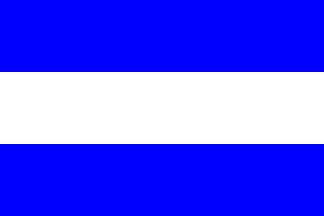
image by Ivan Sache, 15 January 2004
"Colegio Distrital 'Agustín Fernández'", located
in Bogotá, is named after Agustín Fernández (1879-1908), a
pioneer of telegraph in Colombia, murdered in Bogotá. In 1929,
his father, Francisco Javier Fernández Bello, offerred a plot of
land for the building of a rural school to be named after his
defunct son.
The flag of the institute, as shown graphically and described on
the website
of the institute, is horizontally divided blue-white-blue.
Blue, on the first stripe, represents the light enlightening the
way to knowledge, triggering creativity and facilitating
communication. White represents peace, respect and tolerance.
Blue, on the second stripe, represents love and knowledge
transmitting energy and tranquillity.
Ivan Sache, 15 January 2004
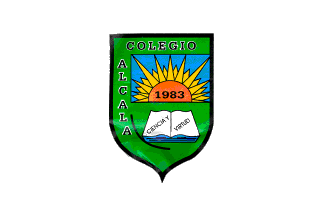
image by Ivan Sache, 9 January 2004
The College was founded in 1983. Its flag is white with the
shield of the College in the middle.
Source: <www.voluntad.com.co>,
located by Dov Gutterman.
Ivan Sache, 9 January 2004
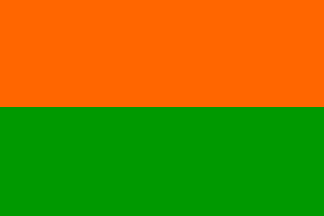
image by Ivan Sache, 3 June 2001
Flag of Colegio Cooperativo 'Alejandrino Restrepo' is based on
<www.multired.com>.
Dov Gutterman, 3 June 2001
Colegio Cooperativo 'Alejandrino Restrepo' is located in the
municipality of Ciudad Bolívar, in
Colombia. The flag of the college is horizontally divided
orange-green. Proportion cannot be infered from the waving image
shown on the website. 2:3 used by default.
Ivan Sache, 3 June 2001

image by Ivan Sache, 29 December 2009
"Institución Educativa 'Alfonso Spath Spath' "
(INEDAS) was founded on 13 January 1993 (Municipal Decree No. 07)
at Martínez, Municipality of Cereté, Department of Córdoba.
The flag of INEDAS, as shown graphically
and described
on the website of the institute, is in proportions 1:2,
vertically divided in two equal parts, the first half being white
and the second half horizontally divided green-red.
White represents cotton.
Green represents the maize fields. Red represents the joy of the
youth.
Ivan Sache, 29 December 2009

image by Ivan Sache, 30 January 2009
"Institución Educativa Agroecológico Amazónico"
was created in the village of La Niña, Municipality of El
Paujil, Department of Caquetá, on 3 December 2003 (Decree No.
603), through the merging of "Concentración John F.
Kennedy", "Colegio San Luis Gonzaga" and
"Collegio Agroecológico Amazónico" (founded on 4
December 1995, Decree No. 1003).
The flag of the institute, as shown graphically on the website
of the institute, is horizontally divided green-white-blue
(1:2:1).
Ivan Sache, 30 January 2009
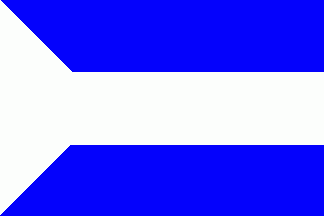
image by Jairo Alonso Méndez Méndez, 14 November 2004
Colegio Americano Menno (La Mesa, Cundinamarca).
Jairo Alonso Méndez Méndez, 14 November 2004

image by Ivan Sache, 8 January 2004
The flag of the College is horizontally divided light
blue-white-light blue.
Source: <www.voluntad.com.co>,
located by Dov Gutterman.
Ivan Sache, 8 January 2004
"Colegio Andino Bilingüe", located in San José de
Cúcuta, Department of Norte del Santander, was recognized by the
Department of Norte del Santander on 30 November 1998 (Decree No.
2935).
The flag of the
institute, as shown graphically and described on the website
of the institute, is green with the emblem of the institute,
outlined in white and surmonting the white writing ANDINO
BILINGÜE / SCHOOL.
Green represents life transmitted by the Andine region.
White represents unity and fraternity.
The emblem of the institute shows in the middle a circle
representing the students, charged with a star representing the
educational values of the institute. The dominant green colour of
the emblem represents the natural environment of the institute.
The upper part of the emblem is made of the upper part of an
ellipse, in yellow, representing the sun, excellence and
knowledge. The two green lateral parts have to be seen jointly,
forming a heart, symbol of the human greatness, a main component
of the philosophy of the institute.
Ivan Sache, 11 January 2004
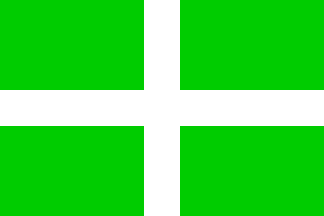
image by Ivan Sache, 11 January 2009
"Institución Educativa Distrital Andrés Bello"
(IEDAB) was founded on 2 July 1953 (Decree No. 1719 of the
Ministry of National Education) as "Colegio Nacional de
Bachillerato Lucio Pabón Núñez". The name of the
institute was changed to "Colegio Nacional de Bachillerato
Sergio Arboleda" in 1957 (Decree No. 1052). "Instituto
Nacional de Bachillerato Andrés Bello" was created on the
same site on 9 February 1960 (Decree No. 437), followed by
"Instituto José María Obando" on 14 June
1973 (Decree No. 1164). On 29 August 1990 (Decree No. 1971), the
three institutes were merged in a new institute, named
"Colegio Nacional Andrés Bello" on 11 March 1991
(Decree No. 668). On 16 September 2002 (Decree No. 2853),
"Colegio Nacional Andrés Bello" was merged with
neighbouring "Centro Educativo Distrital José Joaquín
Castro Martínez" to form "Institución Educativa
Distrital Andrés Bello", eventually renamed
"Institución Educativa Distrital Andrés Bello" on 25
September 2004 (Decree No. 4702).
The institute is named after the humanist Andrés Bello
(1781-1865), also a noted poet, philologist and lawmaker,
credited of the Civic Code of Chile (1852, adopted in 1855 and
subsquently adopted by Colombia and Ecuador), of the foundation
of the University of Chile (1843), and of the first Spanish
American Grammar (1847).
The flag of IEDAB, as shown graphically and described on the website
of the institute, is green with a white cross. The four
quarters of the flag represent:
- the self-confidence of the members of the institute;
- the love for the institute;
- the love for the fatherland;
- the aspiration to knowledge and science.
Ivan Sache, 11 January 2009
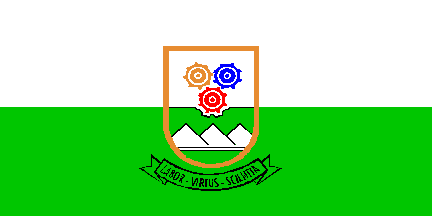
image by Dov Gutterman, 18 April 2003
Image based on <www.tdea.edu.co>.
Dov Gutterman, 18 April 2003

image by Dov Gutterman, 21 July 2002
Image based on <www.udea.edu.co>.
Dov Gutterman, 21 July 2002
The flag of the Department of Antioquia
is derived from the flag of the University of Antioquia.
Carlos Thompson, 23 March 2003
The flag is presented graphically on the university
website, with the following explanation:
- White represents the limpidity of customs, characteristic of
the university life.
- Green recalls hope, permanent virtue and an optimistic horizon.
Ivan Sache, 20 December 2008
"Institución Universitaria Antonio José Camacho",
located in Santiago de Cali, was recognized in 2007 by the
Ministry of National Education (Decree No. 963), succeeding
"Instituto Tecnológico Municipal Antonio José
Camacho" founded in 1993 by the Municipality of Santiago de
Cali (Decree No. 029), itself succeeding "Escuela de
Tecnología en Electrónica", founded by Tulio Ramírez in
1966. An "Instituto Técnico Industrial Antonio José
Camacho" had already been founded in 1933.
The flag of the institute
is shown graphically and described on the institute
website. The flag is horizontally divided blue-yellow-blue
(c. 1:2:1) with a thin red stripe between the fields, and the
emblem of the institute in the middle.
The emblem of the institute is made of a yellow shield charged
with an open book and a flame, surmonted by a blue rising sun and
crossed by two horizontal blue scrolls bearing the white writing
FORMATION INTEGRAL / AL SERVICIO DE LA SOCIEDAD.
Ivan Sache, 20 December 2008
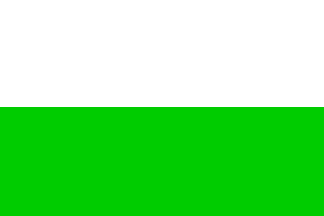
image by Ivan Sache, 10 January 2004
The College was founded in 1943. Its flag is horizontally
divided yellow-green.
Source: <www.voluntad.com.co>,
located by Dov Gutterman.
Ivan Sache, 10 January 2004
"Institución Educativa Departamental 'Antonio
Nariño'" was founded in Bogotá in 1959 by the Department
of Cundinamarca (Decree No. 334) as "Colegio Departamantal
del Magisterio". In 1965, the institute moved to a brand new
seat and was renamed "Colegio Departamental 'Antonio
Nariño'" on 3 April 1965 (Decree No. 363).
On 9 April 1975, the institute was relocated to its present site
at Canelón, Municipality of Cajicá, Department of Cundinamarca.
The flag of the institute,
as shown graphically and described on the website
of the institute, is in proportions 3:5, red with a white
triangle placed along the lower edge of the flag and reaching its
upper edge, The upper half of the triangle is blue and the emblem
of the institute, with a crest made of five yellow teeth, is
placed in the triangle.
The triangle represents the permanent and unidirectional
projection forming the teaching process, involving three
components: the students, the teachers and the supports of
knwoledge. It symbolizes also equality, perfection and
projection.
The sun symbolizes eternity, greatness, power, providence,
nobleness, fame and magnifience.
Yellow symbolizes the sun and its traditional meanings:
nobleness, wealth, power, light, constance and knowledge.
Blue symbolizes the sky and its traditional meanings: justice,
truth, loyalty, charity and beauty.
Red symbolizes fire and its traditional meanings: strength,
victory, temerity, highness and ardor.
White symbolizes the moon and its traditional meanings: purity,
integrity, obedience, firmness, vigilance, eloquence and victory.
Black symbolizes the power and its traditional meanings:
prudence, sadness, rigor, honesty and obedience.
The flag was designed by Humberto Gómez Contreras and
Miguel Oswald Martínez Palacio.
The shield of the institute is quartered. The upper left quarter
shows a portrait of "The Sphinx", the famous Antonio
Nariño, after whom the institute was named. The upper right
quarter shows the map of Colombia with a handshake, which means
"Committed to the building of a better homeland". The
lower left quarter show the Olympic rings, representing sports.
The lower right quarter shows a book, representing knowledge. The
escutcheon in the middle is made of the shield of Cundinamarca.
The shield is placed on a dhisk representing planet Earth and
charged with the name of the institute. A scroll placed below the
disk is charged with the names of the municipality and
department. The colours, yellow, blue, red, are those of the
national flag of Colombia.
The emblem was designed by Javier Alfonso Cárdenas Alonso.
On the drawing of the flag, the emblem is shown in black and
white, with a red outline for the disk, scroll and quarters of
the shield. This seems to be a gross approximation, since another
drawing of the emblem shows it with blue background, yellow
quarters, white letters and red outlines. The emblem of
Cundinamarca is placed on a white disk.
However, on a photo
showing very partially the flag (and completely the emblem), the
letters appear in black, like on the drawing, and not in white!
Ivan Sache, 2 February 2009
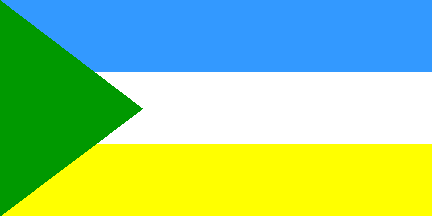
image by Ivan Sache, 31 January 2009
"Institución Educativa Municipal 'Antonio Nariño'"
(INEDAN) is located at Pasto, Department of Nariño.
The flag of the institute, as shown graphically and described by
Luis Eduardo Alvarez (the designer of the flag and emblem,
together with Giovanny Chamorro) on the website
of the institute, is horizontally divided blue-white-yellow
with a green triangle placed along the hoist and covering one
third of the flag length. The overall proportions are specified
as 1:2.
The blue stripe represents stability, depth and clarity of the
institutional horizon, linked to intelligence, knowledge and
sincerity.
The white stripe represents perfection and acts enlightened by
God.
The yellow stripe represents the sun light, joy, intelligence and
energy involved in the educational and cultural acts.
The green triangle represents hope, exuberance, fertility and
freshness characteristic of the natural environment of Pasto.
The municipal flag of Pasto has the
same design, but with different colours. This may not be purely
coincidental.
Ivan Sache, 31 January 2009
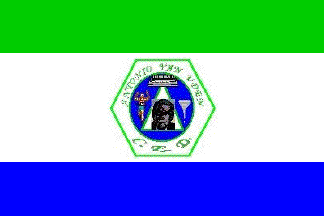
image by Ivan Sache, 28 January 2009
"Colegio 'Antonio Van Uden'" was founded in the
borough of San Pablo de Fontibón, Bogotá, by the Dutch Antonio
Van Uden, and transferred in 1958 to the Federal District of
Bogotá.
The flag of the institute, as shown graphically and described on
the website
of the institute, is horizontally divided green-white-blue
(1:2:1) with the emblem of the institute in the middle.
The emblem of the institute is made of a white triangle outlined
in green and charged with the portrait of Antonio Van Uden,
surrounded by three elements representing the three pillars of
the education provided in the college, "values, science and
technology", the whole placed on a blue disk outlined in
green, inscribed in a white hexagone outlined in green charged
with the name of the institute and representing the educational
duty of the institute, "Education with love, gratitude and
transcendance".
Ivan Sache, 28 January 2009
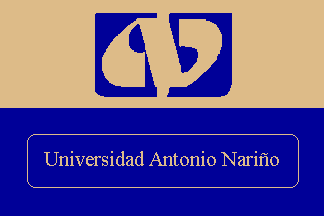
image by Carlos Thompson, 17 March 2003
Universidad Antonio Narino, Bogota,
Colombia (Antonio Narino University) - I have not found this in
their website <www.uan.edu.co>,
but I have seen this flag flying over the main door and at the
director's office.
Carlos Thompson, 17 March 2003
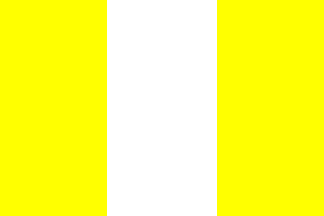
image by Ivan Sache, 15 January 2009
"Institución Educativa Distrital 'Aquileo Parra'",
located in Bogotá, is named after Aquileo Parra (1825-1900),
President of Colombia from 1876 to 1878.
The flag of the institute, as shown graphically on the website of the
institute, is vertically divided yellow-white-yellow.
Ivan Sache, 15 January 2009
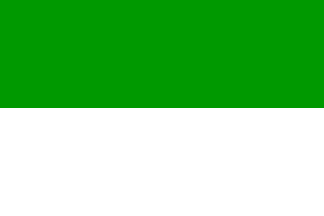
image by Ivan Sache, 3 February 2009
"Fundación Universitaria del Área
Andina" was founded in 1994 in Pereira, Department of
Risaralda. It is made of the Faculty of Health Sciences, Faculty
of Administration, Marketing and Design, and Faculty of Law,
Social and Human Sciences.
The website
of the institute shows a photo of a table flag of the
institute, horizontally divided green-white, with the emblem of
the university "superimposed". The emblem clearly does
not exist on this particular flag but was added subsequently to
the image, therefore it is not possible to conclude about the
existence of a flag with the emblem.
Ivan Sache, 3 February 2009

image by Ivan Sache, 10 January 2009
"Colegio Ateneo Autónomo de Colombia" was founded
on 10 November 1995 by "Sociedad para el Desarrollo de la
Cultura, la Educación y el Trabajo" (SODECET), legally
registered the same day in Neiva, Department of Huila. Classes
started on 28 February 1996. Recognized by the Department of
Huila on 13 June 2001 (Decree No. 563), the institute has
sections in the municipalities of Acevedo, Algeciras,
Campoalegre, Garzón, Guadalupe, Palermo, Pitalito, San José de
Isnos, Suaza and Timaná.
The flag of the institute, as shown graphically and described on
the website
of the institute, is horizontally divided yellow-green with a
red stripe placed vertically along the hoist. Red means strength,
valor and courage required to fulfill the life's project and
contribute to the regional and national development. Yellow
represents loyalty in the personal relationships and social
commitment, as well as the joyous atmosphere of fraternity found
in the institution's activities. Green represents growth and
aspiration to promote values and balanced development.
Ivan Sache, 10 January 2009

image by Ivan Sache, 14 August 2002
Located in Barranquilla, Atlantico Department. The flag shown on
the website is a blue triangular flag with an orange Scandinavian
cross separated from the blue background by a thin white
fimbriation. Exact proportions cannot be infered from the
original source. I have used overall 1:2 proportion by default.
Source: <www.uniatlantico.edu.co>.
Ivan Sache, 14 August 2002